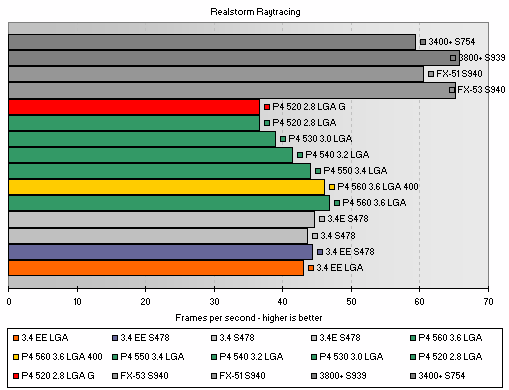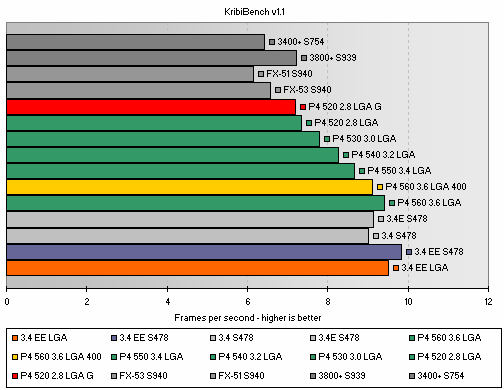CPU Tests

The CPU tests are chosen for their ability to scale very well with changes in CPU frequency, given the same processor core. While the memory subsystem can also affect the following benchmarks, keeping the configuration of that subsystem constant lets us see how the CPUs are able to work on their respecting platforms. What we're really looking for here is the performance gain or penalty from switching your Pentium 4 to LGA775. Again, refer to the key above to spot the CPUs we're most interested in.
Raytracing with Realstorm
Realstorm is a real-time 3D ray tracing engine executed entirely on the CPU, ignoring any 3D power available with an installed GPU. It scales nicely with CPU frequency and loves AMD processors.
Witness nice CPU scaling with the 5xx-series CPUs on LGA775 and identical performance between clock-for-clock Prescotts on Canterwood and Alderwood. Realstorm doesn't really care about access penalties, it just wants a fast FPU and lots of memory bandwidth, hiding any latency disadvantage we get from using DDR-II.
It's interesting to see the 3.4 Extreme Edition on LGA775 losing out to its S478-sited equivalent, since we don't see that performance difference with the Prescott-core chips. Prescott's longer pipeline appears to gain performance in Realstorm, over the shorter pipeline in Gallatin-2M and Northwood. Performance isn't impacted too much by dropping to 400MHz with the 560, that CPU beating out all the other Pentium 4s on test.
The AMD64 chips walk away with Realstorm easily.
MP3 encoding with LAME
LAME is a traditional ignorer of memory bandwidth and access latency, instead snuggling up tight to a speedy FPU. It'll be interesting to see the CPU scaling of the 5xx-series chips, along with any drop or gain in performance when moving to Alderwood and DDR-II.
Again the Extreme Edition processor sees a drop in performance with the Alderwood/DDR-II move, while the Prescott core 540 on Alderwood at 3.4GHz is toe-to-toe with its Canterwood-based equivalent. There's no real penalty from dropping back to Grantsdale, highlighting LAME's unwillingness to acknowledge a lesser performing memory subsystem.
CPU-based 3D performance with KribiBench
KribiBench is another 3D renderer done entirely on the CPU, with a different approach to the problem than Realstorm. We should see the same characteristics with Kribi that we've seen already with Realstorm and LAME. Look out for the 3.4EE drop-off on LGA775.
The drop offs when going to Grantsdale and when dropping to 400MHz memory were inevitable, Kribibench being sensitive to memory performance as well as CPU frequency. The 5xx-series processors go a little slower on Alderwood, compared to Canterwood, with the 3.4EE exhibiting the same difference in speed.









